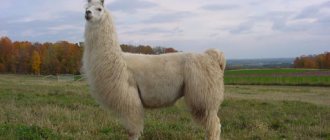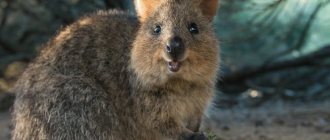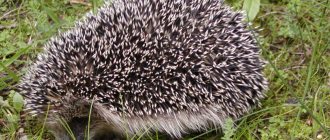Swallows are small birds that belong to the family of swallows in the passerine order. Their difference from other passerine birds is their long wings and tails. The swallow has a wide chest, short neck and flat head. The beak is short, flat, widening towards the base, almost triangular, with a slightly bent end.
The legs are short, weak and with tiny claws. The feathers are short, tightly adjacent to each other, with a characteristic metallic sheen. Female and male individuals differ little in plumage color. On the contrary, chicks in the first days of life are very different in color from adults.
Swallow habitat
Habitat of swallows
Swallows live in almost all regions. For hot countries these are sedentary birds, for the northern regions these are migratory swallows. When frost sets in, the bird flies to warmer regions and returns back in the spring. Usually swallows try to return to their nests from last year. And if these are young birds, then they will certainly begin to build a family nest.
Notes
- 1 2 Boehme R. L., Flint V. E. Five-language dictionary of animal names. Birds. Latin, Russian, English, German, French / Under general. ed. acad. V. E. Sokolova. - M.: Rus. lang., "RUSSO", 1994. - P. 271. - 2030 copies. — ISBN 5-200-00643-0.
- 1 2 Moller, A. 1994. Male ornament size as a reliable cue to enhanced offspring viability. Proceedings of the National Academy of Sciences, 91: 6929-6932.
- 1 2 3 4 Terres, J. 1980. The Audubon Society Encyclopedia of North American Birds. New York: Alfred A. Knopf, Inc.
- McWilliams, G. 2000. The Birds of Pennsylvania. New York: Cornell University Press.
- Hebblethwaite, M., W. Shields. 1990. Social influences on Barn Swallow foraging in the Adirondacks: a test of competing hypotheses. Animal Behavior, 39: 97-104.
- 1 2 Brown, C., B. Brown. 1999. Barn swallow (Hirundo rustica). pp. 1-32 in A. Poole, F. Gill, eds. The Birds of North America, Vol. 452. Philadelphia, PA: The Birds of North America.
- 1 2 Perrins, C. 1989. Encyclopedia of Birds. England: Equinox Ltd..
- Bolzern, A., A. Moller, N. Saino. 1997. Immunocompetence, ornamentation, and viability of male Barn Swallows. Proceedings of the National Academy of Sciences, 94: 54-552.
- Republic Platinum (February 28, 2009). Retrieved September 10, 2009.
- Commemorative coins of Estonia (est.). Eesti Pank - Bank of Estonia. Retrieved September 10, 2009. Archived January 28, 2012.
How many types of swallows are there and where do they live?
Types of Swallows
There are 79 species of swallows. A large number of swallows find shelter in people's houses, some settle on rocks and cliffs, and swallows also choose trees to make nests.
Most species have adapted to build strong nests; the outside walls are made of clay lumps soaked in sticky saliva. Some species, with great difficulty, dig holes in the soil of earthen cliffs, make an extension at the end and build a nest there; most nests consist of a large number of feathers folded in a heap. A clutch usually contains 3-5 eggs, which are incubated only by the female.
Martin
Swallows are usually called noble birds, since they are beautifully gifted in a physiological and aesthetic sense. These birds spend the bulk of their lives in flight. They rest in trees, sitting on branches and twigs without leaves, so that they can easily fly in and fly away.
Swallows are songbirds. They are very understanding and smart. Arriving at a new area, they carefully study it. Swallows have learned to distinguish friends from enemies and will only trust those who earn their trust.
Martin
A small and very beautiful bird nests under the roof of a house. This swallow has chosen your house. Since childhood, everyone has been familiar with this bird, which personifies hope, fidelity and rebirth.
Interesting: Great Horned Owl - interesting facts
People have a particularly reverent and warm attitude towards the swallow. It’s not for nothing that a good-natured and sympathetic person is called a “swallow.”
Lifestyle
Killer whale swallows are migratory birds that lead a diurnal lifestyle. Migration occurs in mid-May, and nesting and egg laying begin in the second half of the month. Females incubate eggs for 12-13 days, after the birth of offspring they feed the chicks for 20 days. The chicks grow up over time and fly out of the nests at the end of June. Mass migration of killer whale swallows can be observed in September. Birds of this breed are very social , they gather in large groups, perch on wires, trees and hills. They also nest in large colonies, within the colony, each pair protects the territory near its nest.
Where do swallows build their nests?
Swallow's nest
Some species of swallows have become so accustomed to people that they build their nests closer to people. However, birds prefer villages rather than big cities. In rural settlements, swallows predominantly choose small but fairly open formations. Stables, sheds, all kinds of terraces, etc. are suitable for building nests for birds. But their favorite place remains the roof of the house.
Swallow nests can also be found in the wild. Birds settle in the desert or vast steppe. But this happens provided that there are no suitable places for construction nearby. Swallow nests are also found under the ceilings of grottoes, under large tree branches, and even under large nests of feathered predators.
Swallow's nest
Swallows are considered skilled builders. They build nests from lumps of wet soil. Birds find wet soil on the banks of lakes and rivers. City swallows collect dirt in puddles. Having found wet soil, the bird rolls it into a ball with its beak. Wet round lumps are firmly attached to the wall. For gluing, the swallow uses its own saliva.
Blades of grass, thin twigs, horsehair and other similar materials are laid out between the balls. The finished nest is covered inside with down and soft blades of grass. The swallow house shape resembles a deep cup. Both the male and the female are involved in nest construction.
Only after the completion of construction does the romantic period of mating begin. Males tell the female about their love with pleasant chirping. And she, in turn, meekly accepts his proposal. Swallows are considered monogamous birds. A couple is created once and forever.
Natural enemies
Swallows are birds with excellent flight characteristics, so they are much more likely to avoid dangerous encounters with various predators. Of particular danger to them is the hobby falcon, which is characterized as a fast and agile predator that is capable of attacking swallows in the air.
Important point! Swallows become vulnerable to their enemies during the period of nest construction, when they fly up to bodies of water to find building material.
Chicks
Swallow chicks
Birds form their family in early spring. The female incubates an average of five tiny eggs per clutch. The chicks hatch within three weeks. Babies are defenseless and not at all adapted to the environment. That’s why parental care is so important to them. The only activity of the emerging chicks is to open their beaks wide and demand food.
From dawn to dusk, parents hunt various insects. Thanks to caring adults, the chicks grow at an unprecedented rate. Well-fed little swallows take their first flight in less than a month. Despite the fact that the chicks have grown up, the parent swallows continue to feed them. Their diet includes all kinds of bugs, flies and even butterflies.
Raising offspring
Swallows mate for life, so they are synonymous with fidelity. The female lays from 3 to 6 eggs. Thanks to their maneuverability and speed of flight, these birds can easily catch a large number of insects, which they feed their chicks. Feeding the offspring is quite a difficult job, since the chicks of one nest eat about 1.2 kg of insects, and their parents feed them up to 400 times a day!
Features of swallows
The swallow catches insects.
One feature helps adults feed their offspring well. The fact is that swallows catch insects on the fly. This greatly reduces the time it takes to search for food. Thanks to this property, birds destroy a large number of harmful insects. People appreciate swallows for this, because where there are swallows, there is a good harvest.
Interesting: Bowerbird nests: photos and videos
These nimble birds not only get food for themselves on the fly, but also eat and even sleep. It’s beautiful to watch how swallows rush headlong over a pond, capturing water with their beaks in flight. Swallows spend almost most of their lives soaring in the air. They rarely fall to the ground, since they are almost not adapted to move on the surface.
Despite their tiny size, swallows are very hardy and have great endurance. They are capable of flying great distances. Long flights require unprecedented strength and patience. After all, migration is always fraught with all sorts of dangers and difficulties.
Nutrition
They feed mainly on insects, namely:
- Grasshoppers.
- Flies.
- Crickets.
- Dragonflies and beetles.
- Ants.
Insects make up 99% of the swallows' total diet. They catch prey in flight and have a good skill in feeding their chicks in flight. However, they sometimes descend to the ground, and they do this more often than other species of swallows. Air layers close to the ground are often used to obtain food. This method of obtaining food distinguishes the barn swallow from the city swallow. Asphalt roads attract barn swallows, since groups of insects usually accumulate , making it easy to catch them. Swallows fly up to the heated asphalt and use their wings to scare away insects, after which they catch them in flight.
Birds of this breed often suffer from a lack of food due to windy weather and cold weather. In such situations, a flock of birds moves to the banks of reservoirs, where there are a large number of thickets. At the same time, their method of obtaining food changes. They stay in a friendly group and make short flights of 2-3 meters along the shore, stopping on plant stems. They fly around the entire shore of the reservoir, scaring away insects from the stems of aquatic plants, after which they catch them. This hunt continues for several days. Swallows save energy and do not strive to move somewhere unless clearly necessary.
What is the difference between a city swallow and a village swallow?
Anyone who likes to watch swallows fly has probably noticed the difference between them. Indeed, in nature there are several species of these fast-winged birds. Many people know that there are city, village and coastal swallows. They have both differences and similarities.
Swallows: coastal, village, city
The city swallow, also known as the swallow, has a slightly shorter tail than its relative. A distinctive feature of this genus is its blue-black back and white breast. Barn swallows have a long forked tail. The forehead and throat are full of reddish plumage. They look quite larger than the city ones. They like to affectionately call the village bird a killer whale. The killer whale also differs from the funnel by the sharp tips of its wings and a fairly wide beak. Pointed wings allow killer whales to demonstrate masterly flight.
Arrival to nesting areas (arrival; nests and their locations; nesting areas)
M. N. Bogdanov wrote that “real spring” begins from the time when “leaves suddenly begin to unfold, as if by magic. You can watch with your eyes how the faint greenery spreads across the birch grove. by evening the whole grove was transformed.” And soon “like a shadow, the first swallow will flash in the air. another one, another and another. old signs hover over the willows and meadows.” Professor at St. Petersburg University, author of excellent popular science books on zoology M. N. Bogdanov was the first to draw attention to the fact that swallows usually arrive immediately after the leaves on the trees turn green; He cited this observation in his essay about the barn swallow. Later, A. N. Karamzin, who observed birds mainly in the Buguruslan region, noted that the barn swallow arrives when “spring has finally come into its own, the steppe turns green and the blossoming forests are covered with a greenish-gray haze.” Poets also drew attention to the connection between the appearance of swallows in spring and other events of the awakening of nature. About spring in central Russia, K. D. Balmont wrote:
In the Caucasus, according to R. G. Gamzatov, on the days of the arrival of swallows, the grass “tiptoes” into the meadows and “the mountains rush to take off their white hats.” Trees and grass begin to turn green when the air gets warmer. The development of vegetation causes an increase in the number of insects; when there are enough of them in the air, killer whales return to their homeland.
Barn swallows, the first to arrive, spend almost all or a significant part of the daytime searching for food, and often hunt over and near bodies of water. But a little time passes, and killer whales appear near their nests and places where they can be built.
Nests and their locations.
Killer whales make nests from wet earth, to which they mix large quantities of straws, blades of grass and horsehair. These additional building materials are often only partially included in the walls of the nest, with the free ends of the blades and straws hanging from the outside of the nest.
23. In rural areas, barn swallows usually nest in human buildings (fogo Yu. B. Shibneva).
Sometimes you can find a nest attached to reed stems hanging from the inside of the roof (photo by A.F. Kovshar) Many are surprised that barn swallows nest in both deserted and crowded places, both in quiet and noisy places, not only on stationary objects, but even on moving vehicles. Undoubtedly, the variety of places chosen by killer whales for nesting indicates the ability of these birds to adapt to different circumstances. Killer whales are usually not afraid of people or quickly get used to them. A great connoisseur of the barn swallow and the author of a book about it, A.F. von Vietinghoff-Riesch, calls the killer whale a mongoose among birds, considering it the most domestic of wild birds. Apparently, killer whales settle on various types of transport when they are stationary, and then adapt to life “on wheels.”
24. In rural areas, barn swallows usually nest in human buildings (fogo Yu. B. Shibneva). Sometimes you can find a nest attached to reed stems hanging from the inside of the roof (photo by A.F. Kovshar)
25. In sparsely populated rocky areas, killer whales settle in their original nesting places: either in a rock crevice: the shore of Lake Ladoga (photo by K. N. Bobrov), or on a wall in a cave: Altai (photo by P. P. Strelkov)
Barn swallows nest on the walls of buildings, usually in cases where they are no longer able to enter the premises in which they lived before. For example, in the Lithuanian city of Simnas, almost half of the pairs of killer whales began to nest outside buildings after some residents converted their stables and sheds into garages and warehouses, tightly closing all more or less significant openings. In the village of Zherebut, from time to time, some pair of barn swallows lived in a nest built outside a hut or outbuilding, despite the fact that the attic windows were wide open in the summer, and there were holes in the gables through which the birds could freely fly inside the premises. However, having lost free access to the interior (many village residents sealed large cracks in the attics, glazed all the windows, and began keeping the doors of outbuildings closed throughout the day), about half of the killer whale pairs nesting in the village made their nests outside the buildings. Interestingly, one pair did nest in the attic, which seemed to be tightly sealed. The birds climbed into the attic through the gap between the gable board and the roof and flew through the attic to the nest.
26. In sparsely populated rocky areas, killer whales settle in their original nesting places: either in a rock crevice: the shore of Lake Ladoga (photo by K. N. Bobrov), or on a wall in a cave: Altai (photo by P. P. Strelkov)
After the destruction of single buildings or villages in which barn swallows previously nested, birds often continue to settle in their former locations, building nests in ruins, in cellars and wells, on nearby rocks (crater holes that found themselves in such conditions also populated ruins, rocks, even trees). For example, on the site of the former lumber camp of Vasilyev Bor (Karelia), 10-15 pairs of killer whales nested in preserved wells.
Barn swallows attach nests to wooden, stone, brick, stucco and concrete walls of buildings.
Most of these swallows nest in those villages where they keep a lot of livestock. Thus, in one village in the Amur region, in a room where livestock was kept in the summer, 27 residential killer whale nests were counted, and in another, where there was no livestock, only old nests not occupied by swallows were found. The connection between the number of livestock and the number of nesting pairs is more pronounced in the barn swallow compared to the funnel swallow, but it exists only where livestock are still kept in dimly lit rooms with low ceilings, windows and doors that are not closed in summer, and with manure in which they breed. insects. Where modern, large, bright and very clean premises for keeping livestock have been built, the number of killer whales has noticeably decreased.
In cases where killer whales nest on the walls of buildings, the city swallows sometimes claim the places they have chosen for nests, started and finished nests and, after one or several days of struggle, gain the upper hand over the killer whales.
Adult barn swallows show great attachment to their nesting site. Thus, more than half of the killer whales that returned to one of the villages in Germany in the spring nested in the same places as last year, and the rest moved no further than 400 meters from their previous nesting sites. In Japan, also, 3/4 of old birds in the spring settled in those houses where they bred before. Some individuals occupy the same nest for several years in a row.
Typically, killer whales change nesting sites when they fail to reproduce. They are prompted to do this by various kinds of concerns. In short, adult killer whales apparently prefer to live in an area that is familiar to them, since it takes time and effort to get acquainted with a new area, and if they move, it is due to the deterioration of certain living conditions in the previous nesting place. In recent years, in the mentioned village of Merevo, A.S. Malchevsky observed relatively many pairs of killer whales only in the spring. They sang, carried straws into attics, spent the night next to houses, but then most of them disappeared. As already mentioned, wandering killer whales searching for nesting areas are found far from their breeding areas. In some areas where killer whales have not previously lived, they appear in the very first summer after human construction of buildings. Compared to males, females migrate more often and over longer distances.
Source
Signs associated with swallows
For example, if swallows arrived in early spring, it means there will be a good grain harvest in the fall, but if they arrive late, you may not expect a generous harvest. Before the rain, these birds begin to fly low above the surface of the earth. And before a clear and warm day, you can hear their cheerful and sonorous chirping.
Swallow before the rain
A flock of swallows has always been considered a very auspicious sign. If you notice a flock rushing overhead, it means good luck to you. If swallows scurry around your house, expect good luck. And if a flock flies over the lovers, then great mutual love awaits the couple.
Interesting Facts
Folk signs about swallows.
The significance of swallows in folklore is great. There are many folk signs and ideas associated with this bird. For example, in Russia the swallow represents prosperity, tranquility and peace, while in Ireland this bird is read as the “devilish spawn”.
Existing signs about swallows
Common signs
Why do you dream about a swallow?
It is believed that the swallow is a symbol of change and renewal. If a swallow circles overhead in a dream, this means that news from relatives awaits you. A flock of swallows dreams of unexpected but pleasant news. Seeing a swallow separated from the flock and flying straight towards you means meeting an old friend.
The picture shows a swallow
Seeing a bird sitting in a nest means a calm future; troubles will be avoided. If a bird hatches eggs, wealth will come soon. Swallow chicks dream of an early easy pregnancy.
A swallow lands on your shoulder - positive changes are expected. An unmarried girl will soon get married, a lonely girl will find a suitor. In such a dream, careerists can hope for a quick promotion or increase in salary. Holding a swallow in your hands means wealth, a comfortable and happy life.
Swallow bird tattoo means youth, prime of life, good luck. In addition, for women, a swallow symbolizes motherhood, procreation, and care for offspring. Young people place similar tattoos on the clavicular depressions or shoulder blade.
Swallows' vision
Swallow
The swallow has very good eyesight. She perfectly sees a tiny insect in flight at a distance and pursues it, orienting herself only with her eyes. The barn swallow sets up a nest in a building so that it is covered from above with a roof. It happens that large companies settle in such places. The nest looks like a quarter of an empty ball. On average, it takes one pair eight days to build a nest. Stems, hair, feathers and other soft materials are spread inside the nest. A swallow's nest can last for several years and for subsequent generations.
Interesting: Why don't some birds fly south? List, reasons, description, photos and videos
Chick development
The duration of incubation depends on weather conditions and ranges from several weeks in good weather to a month in bad weather. Both parents are involved in incubation and further feeding of the young. The chicks stay in the nest for no more than three weeks. During this period, they manage to go through all stages of formation, become sighted and fledge, beginning to resemble adult birds as much as possible. At the end of the second week they already begin to fly out of the nest. At first, the swallow chick prefers to stay close to the nest, as the adults continue to feed it.
Only by autumn the young animals gather in flocks and begin, following the example of their parents, to lead a nomadic lifestyle, feeding independently until they fly away. In the fall, before flying to warmer climes, you can often see jackrabbits sitting on telegraph wires, wire fences, or flying high above fields and meadows. Since crowed birds are migratory birds, with the onset of the first cold weather you can see them flying to South Africa or southern Asia for the winter.
Barn Swallow
The barn swallow's
upper body and crop are dark blue, with a metallic tint. The throat and forehead are bright chestnut. The bottom is light yellowish in color. Females are distinguished by paler shades from males. Barn swallows are found throughout Europe, western and central Asia.
This species of swallow has been accustomed to man and his home since ancient times. Her attachment to a human home led to our love for her, and in the northern countries people were taught to consider the arrival of a swallow as the beginning of spring, and the departure as the beginning of dull autumn.
City swallow
City Swallow
The entire body of the city swallow is covered with blue-black feathers, only the tail is white below. The eyes are brown, the beak is almost black. The chicks have black plumage. The city swallow is found almost in the same place as the village swallow and also a little to the north. This species of swallow builds nests only on buildings, with protection from the rain on top. The shape of the nest resembles that of a barn swallow. Nest construction lasts 10-15 days.
Beregovushka
Shore Swallow and Nest
The feathers on top are earthy-brown in color; below - white with a brown-ash stripe on the chest. The shorebird is common in most areas; it settles mainly on steep banks. With great effort, they dig deep holes for nests in the dense earth, most often along the top of a slope, so that water does not flood them.
Thread-tailed Swallow
Thread-tailed Swallow
The wings are narrow and long, the tail is long and fork-shaped. The beak is short and triangular in shape. The legs are short and weak, but with tenacious claws. Thanks to which swallows cling to walls and steep cliffs. The top of the body is dark, with a blue tint, and the bottom is light.
Swallows are monogamous birds; partners remain faithful to each other for one season. In the northern regions, swallows make one clutch per year, in the southern regions - 2 clutches.
Swallows are quite stable and can withstand various loads well. These birds bring great benefits to humans by exterminating small insects that other birds do not eat - mosquitoes and flies.
When did the finches arrive?
They usually arrive in early April, but this year their songs in the parks were heard already in mid-March. After all, these are all songbirds, and although it is not always possible to see them in the branches of trees, everyone can hear the spring trills. The first finches were recorded in the Izmailovsky and Terletsky forest parks.
Interesting materials:
How to quickly chop carrots the Korean way? How to quickly clear friends? How to quickly peel pistachios? How to quickly clear redcurrant branches? How to quickly clean rapana? How to quickly cool porridge? How to quickly unsubscribe from all YouTube channels at once? How to quickly move things in Minecraft? How to quickly drag things from inventory to chest? How to quickly clean smelt?











